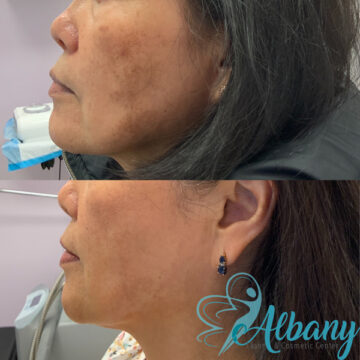Everything you wish to know about skin hyperpigmentation treatments
We help patients get clear, radiant skin with innovative treatments at Albany Cosmetic and Laser Centre by offering skin hyperpigmentation treatment in Edmonton and St. Albert. We want everyone to feel good about themselves and look beautiful. That’s what we work towards. Our skilled team helps patients with hyperpigmentation disorders using advanced treatments for the skin they want.
We help with skin spots like age spots, liver spots, and freckles.Moreover, our team give you personal care and advice to solve hyperpigmentation problems. With a philosophy centered on excellence and compassion, we are proud to be the trusted choice for skin care in Edmonton.

Understanding hyperpigmentation in Edmonton
Hyperpigmentation disorders are a common skin concern that can have a significant impact on a person’s appearance and confidence. These conditions are characterized by dark, discolored patches or spots on the skin that can appear anywhere on the body.p>
Dark spots on the skin are caused by too much melanin in some areas. This includes age spots, liver spots, and freckles.This overproduction can be triggered by a variety of factors, including sun exposure, hormonal changes, and genetics.
The result is an uneven skin tone that can be noticeable and unsightly. With the right treatment, however, it is possible to restore a clear, even complexion and regain confidence in your appearance.
Factors that contribute to Hyperpigmentation in St, Albert
Hyperpigmentation is caused by an overproduction of melanin, the pigment that gives color to our skin. This overproduction can be triggered by a variety of factors, including sun exposure, hormonal changes, and genetics.
Sun can cause hyperpigmentation by damaging skin and causing too much melanin. Hormonal changes, such as those that occur during pregnancy, can also cause hyperpigmentation. And for some people, hyperpigmentation is simply a result of their genetics.
Hyperpigmentation is a common skin problem. However, There are Hyperpigmentation treatments in Edmonton to help manage it, no matter what caused it. At Albany Cosmetic and Laser Centre, we help patients with hyperpigmentation. We explain the cause and create a treatment plan to achieve clear, even skin.
The expected Hyperpigmentation treatment results


There is no definitive answer to this question. At Albany Laser and Cosmetic, we offer top laser machines for skin care. These include Spectra nano-second, Fraxel Dual with two wavelengths, and Fotona laser.
The combination is critical for achieving the best results in hyperpigmentation treatment in Edmonton.“There Dr. Kamal, a Pharmacy Doctor, says we can help people with dark spots caused by acne, sun, age, or melasma. There are many things we can do to help. We use chemistry, laser light, and microneedling to make hyperpigmentation look better for many patients.
Hyperpigmentation is a common problem on the face that can be upsetting for clients. Luckily, it is treatable. Lasers and other treatments work well for these disorders, helping patients achieve their desired appearance. Best of all, the treatments are quick and usually do not need to be repeated too frequently.
Hyperpigmentation Treatments Frequently asked questions
What Is Skin Hyperpigmentation?
- Despite the fact that hyperpigmentation is not dangerous, it can make people feel self-conscious and difficult to heal. Skin problems like acne, eczema, and allergies can cause dark spots.
- Treatments like surgery, microdermabrasion, lasers, and chemical peels can also cause them. This damage stimulates the release of inflammatory cells, which induce pigment cells in the skin to create more pigment.
What Causes Hyperpigmentation?
- Sunbathing, tanning booths, and neglecting the use of sunscreen can all cause hyperpigmentation. Excessive sun exposure can cause sunspots, age spots, and black patches over time.
- Melasma, on the other hand, is caused by a hormonal imbalance and is more frequent in pregnant women. Melasma can also be caused by genetic composition, which can be passed down from generation to generation.
What Are the Most Effective Treatments for Hyperpigmentation?
- These therapies have extensive recovery durations and, in some situations, might cause further skin damage.
- They can even draw attention to hyperpigmentation. However, because of improvements in technology, there are now hyperpigmentation treatments that are both effective and gentle on your skin. The Laser Spectra Peel is an example of one of these procedures.
- Heat and light are used in this hyperpigmentation therapy to target and eradicate the darkened patches. Energy breaks down melanin in the area, is absorbed by the body, and disappears.
How soon will I start seeing results from treatments for simple hyperpigmentation?
What are the benefits of using Fractional Laser for skin pigmentation?
- It is also used to help erase age spots, dark circles under the eyes, acne scars, and other skin imperfections.
- This laser treatment sends strong light into skin layers to make more collagen and even skin color. Benefits of treatment include better skin texture, less sun or age spots, more hydration, and less acne scarring.